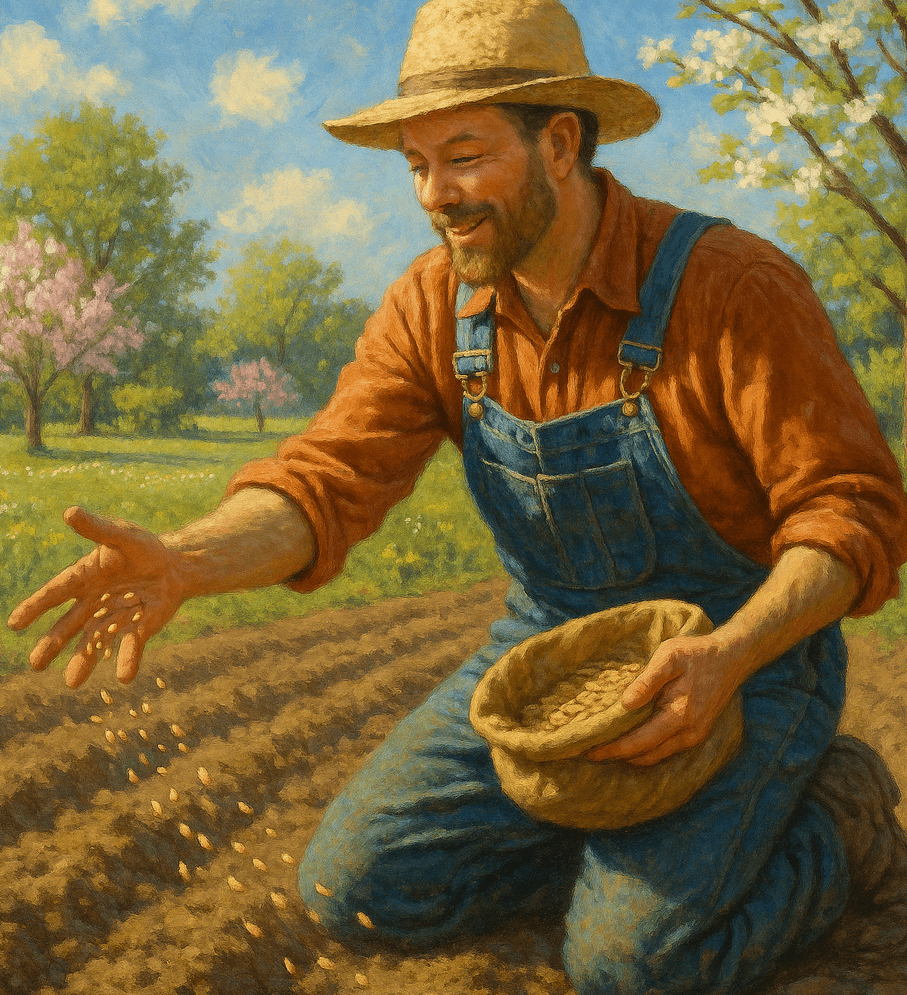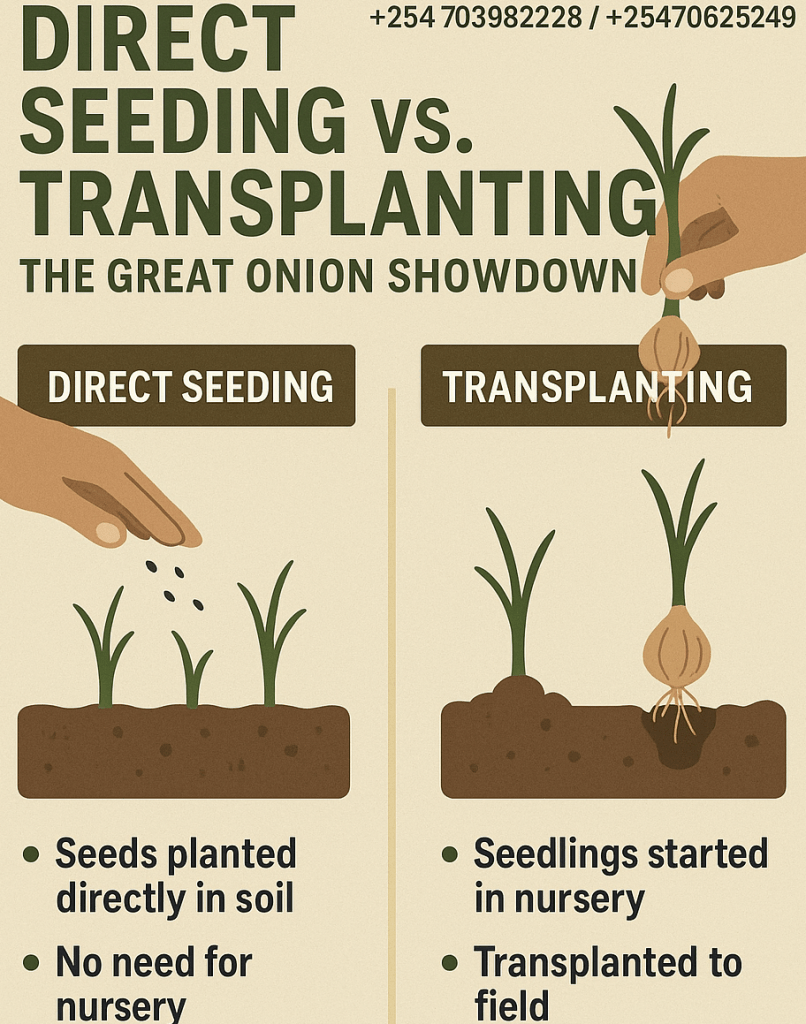Welcome to Onion Doctor, where we dig deep into the world of alliums with passion, humor, and a sprinkle of dirt under our nails! Today, we’re tackling one of the juiciest debates in onion growing: Direct Seeding vs. Transplanting. Which method will reign supreme for your onion patch? Buckle up, because we’re about to unearth the pros, cons, and everything in between in the most fun, engaging, and onion-obsessed way possible!

WHAT IS THE DEAL WITH DIRECT SEEDING AND TRANSPLANTING?
Before we dive in, let’s break it down. Onions, those tear-jerking, flavor-packed bulbs, can be grown in two primary ways:
- Direct Seeding: You sow onion seeds straight into the garden soil, where they’ll germinate, grow, and bulb up without ever leaving their cozy dirt bed. It’s like telling your onions, “You’re home, babies—stay put!”
- Transplanting: You start onion seeds indoors (or buy seedlings), nurture them like delicate royalty, and then transplant them into the garden when they’re ready to face the world. It’s the onion equivalent of moving from a nursery to a big-kid bed.
Both methods have their fans, but which one’s the best for you? Let’s compare them.
ROUND 1: DIRECT SEEDING:
Direct seeding is the “set it and forget it” of onion growing. You prep your soil, scatter those tiny black onion seeds, cover them lightly, and let nature do its thing. It’s perfect for gardeners who want to keep things simple and avoid the hassle of indoor setups.
- Pros:
- No need for trays, grow lights, or indoor space. Your garden is your nursery!
- Less equipment means lower startup costs—more money for that fancy onion soup recipe.
- Minimal disturbance to roots, so your onions grow stress-free from the get-go.
- Cons:
- Slower germination. Onion seeds can take 7–14 days to sprout, and they’re not exactly Usain Bolt in the growth department.
- Weeds love to crash the party. You’ll need to be vigilant about keeping your onion bed weed-free, as those tiny seedlings aren’t great at competing.
- Weather dependency. A cold snap or heavy rain can ruin your seed party before it even starts.

TRANSPLANTING:
Transplanting is for the onion growers who love a bit of pampering. You start seeds indoors, giving them a head start in a controlled environment, then move them to the garden when they’re sturdy little green soldiers.
- Pros:
- Faster time to harvest. Transplants are already 6–8 weeks old when they hit the garden, shaving weeks off your growing season.
- Better weed control. By the time you transplant, your onions are strong enough to outcompete those pesky weeds.
- Ideal for short-season climates. If your growing season is shorter than an onion’s temper, transplants give you a leg up.
- Cons:
- More work upfront. You’ll need trays, potting mix, grow lights, and a knack for keeping seedlings happy.
- Transplant shock. If you’re not gentle, your onions might sulk for a bit before settling in.
- Higher costs for supplies (or buying seedlings if you skip the indoor step).

ROUND 2: COST AND RESOURCES:
Direct Seeding: The Budget Friendly Option:
If your wallet’s feeling as thin as an onion skin, direct seeding is your friend. A packet of onion seeds costs just a few shillings and can yield hundreds of plants. Plus, you don’t need fancy gear—just good soil and a sprinkle of hope.
- Cost Breakdown:
- Seeds: KSh 10,000–20,000.
- Soil prep: Compost, fertilizer, and maybe a hoe (KSh 15,000–25,000).
- Time: A few hours to sow and maintain.
- Catch: You might lose some seeds to poor germination or critters, so factor in a buffer for replanting.
Transplanting : The Investment plan:
Transplanting is like signing your onions up for private school—it’s pricier but comes with perks. You’ll need indoor growing supplies or the cost of buying seedlings, which can add up.
- Cost Breakdown:
- Seeds: KSh 10,000–20,000 (same as direct seeding).
- Supplies: KSh 2,000–10,000 for trays, lights, and potting mix.
- Seedlings (if purchased from Onion Doctor): 1 bob per seedling.
- Time: Weeks of care plus transplanting day.
Winner: Direct seeding wins for penny-pinchers, but transplanting’s worth it if you’re investing in a bumper crop.
ROUND 3: YIELD AND QUALITY:
Direct Seeding:
Direct-seeded onions are tough cookies. They grow where they’re planted, adapting to your soil and climate from day one. This can lead to resilient plants, but the results can vary.
- Pros:
- Strong root systems, as they’re never disturbed.
- Great for long-season varieties (like storage onions) that don’t mind a slower start.
- Cons:
- Uneven germination can lead to a patchy crop.
- Smaller bulbs in some cases, especially if spacing or thinning isn’t perfect.
Transplanting:
Transplants are like onions with a personal trainer—they’re primed for success. Starting them in a nursery lets you control their early growth, leading to uniform, picture-perfect bulbs.
- Pros:
- Bigger, more consistent bulbs, especially for sweet varieties like Walla
- Better spacing control, as you place each plant exactly where you want it.
- Cons:
- Risk of transplant shock can stunt growth if not done carefully.
- Some varieties don’t love being moved and may bolt (flower prematurely).
Winner: Transplanting takes the crown for premium, market-ready onions, but direct seeding holds its own for rugged reliability.
THE ONION DOCTOR`S ULTIMATE VERDICT:
So, which method is the best in the world for growing onions? It depends on you, dear Onion Doctor reader! Here’s our cheat sheet to decide:
- Choose Direct Seeding If:
- You’re a low-maintenance gardener who loves simplicity.
- You’re growing storage onions or have a long growing season (130+ days).
- You’re on a budget and want to keep costs low.
- You enjoy the rustic charm of seeds sprouting in the wild.
- Choose Transplanting If:
- You’re in a short-season area (under 100 days) or want faster results.
- You’re aiming for big, beautiful bulbs for market or kitchen glory.
- You love the hands-on process of nurturing seedlings.
BONUS TIP:
No matter which method you choose, here are some universal tips to make your onions the envy of every gardener:
- Soil Prep: Onions love loose, well-drained soil with a pH of 6.0–6.8. Add compost and a balanced fertilizer before planting.
- Spacing: For direct seeding, sow seeds ½ inch deep, 1 inch apart, and thin to 3–4 inches. For transplants, space 4–6 inches apart for big bulbs.
- Watering: Keep soil consistently moist but not waterlogged. Onions are thirsty but hate soggy feet.
- Variety Matters: Match your onion variety to your region’s climate warm region varieties and cold region varieties.
- Weed Control: Onions hate competition, so weed early and often. A mulch layer can help.

Contact us for: Onion seedlings, Garlic seedlings, Germinated garlic cloves, Farm planning services, Soil testing, training on onion and garlic growing, Drip irrigation installation and maintenance, Agronomic support, Onion and Garlic value pack and Farm management. For free consultation, placing orders or booking a visit with an agronomist, please contact us via Call or what’s app +254703982228, Email: Info@oniondoctor.co.ke. You can also check out our social media handles for daily updates on TikTok: https://www.tiktok.com/@oniondoctorke?_t=ZM-8wmsTu0qumO&_r=1 Instagram: https://www.instagram.com/oniondoctorke?igsh=MTVoaHF3aWUydTJzaQ==Facebook:https://www.facebook.com/share/16SwgYn2dG/ Youtube:https://youtube.com/@oniondoctorke?si=u5Jnd-r0qU9UDYqL and Twitter: https://x.com/OnionDoctorKe?t=FR3JXlS_oN1vjjUgAtfyzg&s=09.